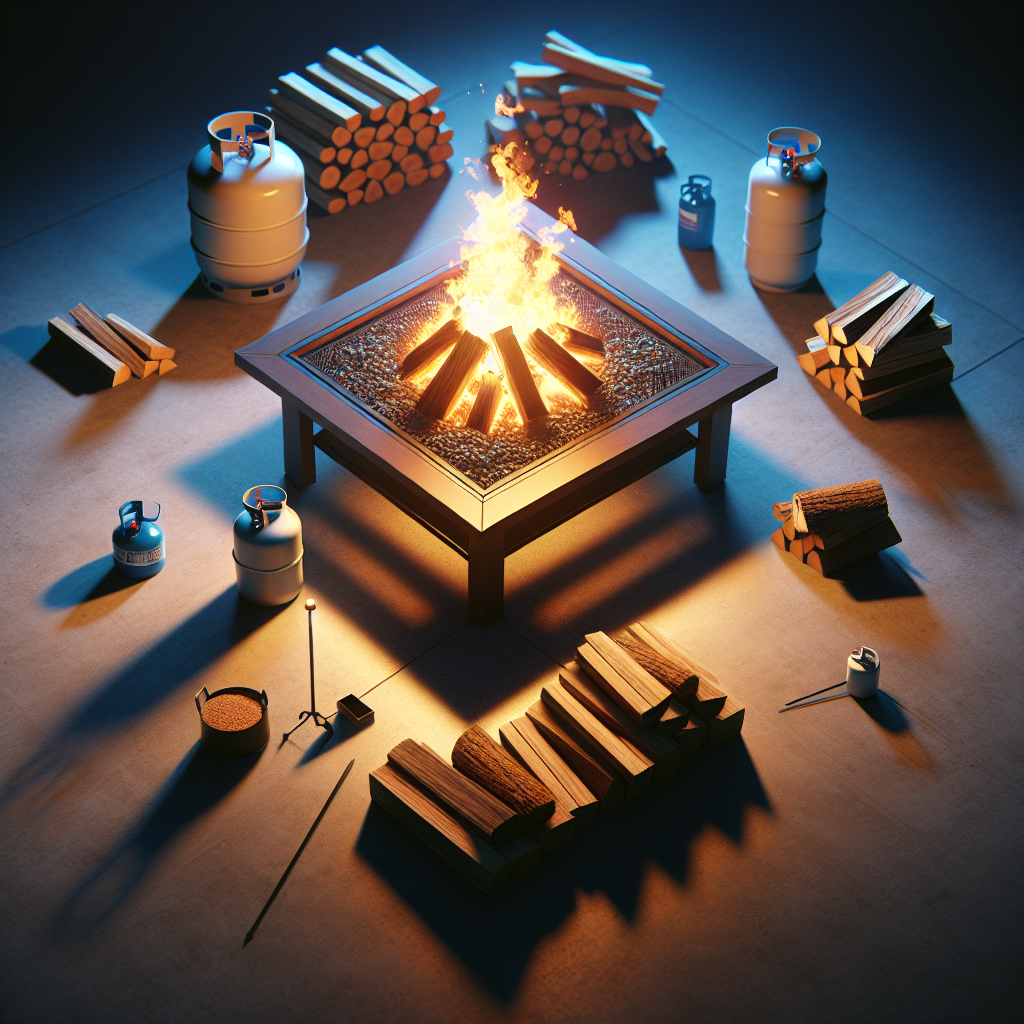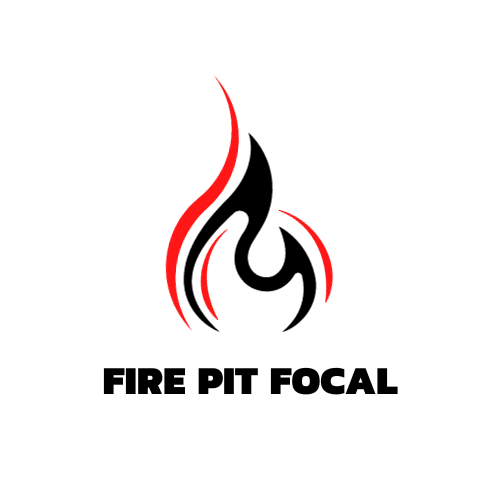If you enjoy cozy evenings around a fire pit table, it’s important to prioritize safety, especially when it comes to using them near flammable materials. This article aims to provide you with essential safety precautions to ensure you can safely enjoy the warmth and ambiance of your fire pit while minimizing the risk of accidents or damage to nearby flammable materials. By following these guidelines, you can relax and fully immerse yourself in the comforting glow of your fire pit table without worrying about potential hazards.
Choosing a Suitable Location
Understanding Fire Regulations and Codes
When choosing a location for your fire pit table, it is crucial to have a good understanding of the fire regulations and codes in your area. Different regions may have specific rules regarding the use of fire pits and the distance they should be kept from flammable materials. By familiarizing yourself with these regulations, you can ensure that your fire pit table is installed in a safe and compliant manner.
Keeping an Adequate Distance from Flammable Materials
One of the most important safety precautions to take when using a fire pit table is to maintain a sufficient distance from any flammable materials. These materials can include outdoor furniture, trees, shrubs, or even the exterior walls of your home. It is recommended to keep a minimum distance of at least 10 feet between the fire pit table and any potentially flammable objects. This distance will help prevent accidental fires and reduce the risk of spreading flames.
Avoiding Enclosed Spaces
Another safety precaution to keep in mind is to avoid using your fire pit table in enclosed or confined spaces. Fire pits require proper ventilation to allow for the efficient flow of air and the release of smoke. Using a fire pit table in an enclosed area, such as a screened porch or indoor space, can lead to a buildup of smoke and carbon monoxide, which can be harmful to your health. Always ensure that your fire pit table is used in a well-ventilated outdoor area to minimize any potential risks.
Considering Wind Conditions
Wind conditions can greatly affect the safety and enjoyment of your fire pit table. It is important to consider the prevailing wind direction and speed when selecting the location for your fire pit table. Positioning the table in an area where the wind will blow towards open spaces rather than towards flammable materials is crucial. Additionally, be aware of strong wind gusts, as they can cause flames to spread or reignite embers. Always exercise caution and be prepared to extinguish the fire if wind conditions become unsafe.
Preparing the Surrounding Area
Clearing Debris and Flammable Items
Before using your fire pit table, it is essential to thoroughly clear the surrounding area of any debris or flammable items. Remove dry leaves, twigs, and branches from the vicinity as they can easily catch fire from the flames or embers. Additionally, ensure that there are no flammable items such as propane tanks or gasoline containers near the fire pit table. By keeping the area clear of flammable materials, you minimize the risk of accidental fires and create a safer environment for everyone.
Creating a Fireproof Barrier
To further enhance the safety of your fire pit table, consider creating a fireproof barrier around the immediate area. This can be achieved by using fire-resistant materials such as bricks or stones to create a designated space for the fire pit table. The barrier should extend beyond the edge of the table and provide a buffer zone between the flames and any nearby flammable materials. This added protection can help prevent accidental ignition and minimize the spread of fire.
Ensuring Proper Ventilation
proper ventilation is crucial for the safe operation of a fire pit table. Ensure that the area surrounding the table has adequate airflow to allow for the release of smoke and gases. Avoid placing the table near walls, fences, or any other structures that may impede the ventilation. Good airflow will not only prevent smoke buildup but also reduce the risk of carbon monoxide poisoning. Regularly check that the table is not obstructed and that the surrounding area allows for proper ventilation.

Selecting the Right Fire Pit Table
Choosing a Sturdy and Stable Design
When selecting a fire pit table, it is important to choose one that is sturdy and stable. Look for a table made from high-quality materials such as cast iron, stainless steel, or heavy-duty aluminum. These materials not only provide strength and durability but also withstand the heat generated by the fire pit. Additionally, ensure that the table has a stable base or legs that can securely hold the weight of the fire pit and prevent it from tipping over.
Opting for Fire Pit Tables with Safety Features
To maximize safety, consider opting for a fire pit table that is equipped with built-in safety features. Some tables may have features such as flame guards or heat shields that help prevent accidental contact with the flames. Others may have spark screens or protective covers to prevent embers from flying out. These safety features can provide an added layer of protection and peace of mind while enjoying your fire pit table.
Considering the Size and Placement
The size of your fire pit table and its placement within your outdoor space are also important factors to consider for safety. Choose a size that is appropriate for your available space, ensuring that there is ample room for people to move around without getting too close to the flames. Additionally, consider the placement of the table in relation to other structures or objects. Avoid placing it too close to walls, overhanging branches, or any other potential fire hazards. Proper sizing and placement will help minimize the risk of accidents and allow for a safe and enjoyable experience.
Proper Handling of Fire and Fuel
Using Approved Fuels
To ensure the safety of your fire pit table, it is essential to use approved fuels that are suitable for outdoor fireplaces. Avoid using flammable liquids, such as gasoline or lighter fluid, as these can lead to uncontrollable fires and pose a significant risk. Instead, opt for clean-burning fuels specifically designed for fire pit tables, such as natural gas or propane. These fuels are safer, cleaner, and produce fewer emissions, making them a responsible choice for your fire pit table.
Avoiding Overfilling the Fire Pit
When using your fire pit table, it is crucial to avoid overfilling the fire pit with fuel. Overfilling can cause the flames to become too high and unstable, increasing the risk of accidents or fire spread. Follow the manufacturer’s guidelines for the recommended fuel level and never exceed the maximum capacity of the fire pit. It is always better to start with a smaller amount of fuel and add more if needed, rather than risking an overfilled and potentially dangerous fire pit.
Extinguishing the Fire Safely
At the end of each use, it is essential to thoroughly extinguish the fire to prevent any potential accidents or fires. Allow the fire to burn down naturally or use a fire extinguishing tool to safely put out the flames. Avoid pouring water directly onto the fire pit, as the sudden temperature change can cause thermal shock and damage the materials. Instead, use sand or a fireproof cover to smother the flames and ensure that no lingering embers remain. Once the fire is completely extinguished, remember to let the fire pit cool down before leaving it unattended.

Ensuring Adequate Fire Safety Equipment
Having a Fire Extinguisher Nearby
As an essential safety precaution, always have a fire extinguisher readily available near your fire pit table. Choose a fire extinguisher suitable for putting out fires caused by flammable liquids or electrical equipment. Ensure that it is easily accessible and in good working condition. Familiarize yourself with its proper usage and keep everyone aware of its location and operation. In case of an emergency, a fire extinguisher can be a crucial tool in quickly and effectively extinguishing a fire.
Keeping a Fire Blanket Handy
In addition to a fire extinguisher, it is also beneficial to keep a fire blanket handy near your fire pit table. A fire blanket is a large, flame-resistant cloth that can be used to smother small fires or wrap around someone to help extinguish flames on their clothing. When using a fire blanket, remember to carefully follow the instructions provided. Keep the blanket in an easily accessible location, ensuring that everyone knows its purpose and how to use it if needed.
Equipping with a First Aid Kit
Accidents can happen, and it is essential to be prepared for any injuries or burns that may occur around the fire pit table. Keep a well-stocked first aid kit nearby, containing items such as bandages, antiseptic ointment, burn gel, and sterile dressings. Ensure that the kit is up to date and replenish any used supplies promptly. Educate yourself and others on basic first aid procedures, especially for burns and minor injuries. Having a first aid kit readily available adds an extra layer of safety and allows for immediate treatment in case of accidents.
Educating Users on Fire Safety
Informing Users about Safety Precautions
It is crucial to provide clear and concise information to everyone who will be near or using the fire pit table. Inform users about the safety precautions they need to follow, emphasizing the importance of responsible and cautious behavior. Clearly communicate the rules and guidelines regarding the use of the fire pit table and the surrounding area. Encourage everyone to be vigilant and report any potential hazards or concerns immediately. By raising awareness and educating users on fire safety, you create a safer environment for everyone involved.
Providing Clear Instructions on Operating the Fire Pit Table
To ensure the safe operation of the fire pit table, provide clear instructions on how to properly use and maintain it. Outline the steps for starting the fire, adjusting the flames, and extinguishing the flames at the end of each use. Emphasize the importance of never leaving the fire pit table unattended and avoiding any unsafe practices, such as using flammable accelerants. By providing clear instructions, you empower users to make informed decisions and reduce the risk of accidents or misuse.
Highlighting Emergency Protocols
In the event of an emergency, it is essential to have clear and established emergency protocols in place. Outline these protocols and ensure that all users are aware of them. Include procedures for evacuating the area, contacting emergency services, and providing first aid if necessary. Clearly mark emergency exits or escape routes and keep them unobstructed at all times. By highlighting emergency protocols, you can minimize the potential risks and ensure a swift and organized response to any emergency situation.

Supervision and Maintenance
Never Leaving the Fire Pit Unattended
One of the most important safety precautions to follow is to never leave the fire pit unattended. Even a small fire can quickly escalate and cause significant damage if left unsupervised. Always designate a responsible adult to keep an eye on the fire pit table and ensure that it is continually monitored during use. This person should be trained in fire safety procedures and equipped with the knowledge to handle any potential issues. By providing constant supervision, you can quickly address any emerging safety concerns and prevent accidents from occurring.
Regularly Inspecting and Cleaning the Fire Pit Table
Regular inspections and cleaning of the fire pit table are vital for maintaining its safety and functionality. Before each use, inspect the table for any signs of damage or wear. Check the stability of the structure, the integrity of the fuel lines (if applicable), and ensure that all safety features are intact. Clean the table regularly to remove any debris, ashes, or residue that may accumulate. Proper upkeep and maintenance will help prolong the lifespan of your fire pit table and ensure it remains in optimal condition for safe usage.
Checking for Gas Leaks
If you are using a gas-powered fire pit table, it is important to regularly check for gas leaks to prevent any potential dangers. Gas leaks can lead to explosions or fires, posing a severe risk to everyone nearby. Before each use, inspect the gas lines, connectors, and valves for any signs of damage or leaks. If you detect a gas odor or suspect a leak, immediately shut off the gas supply, ventilate the area, and contact a professional for assistance. Regular checks for gas leaks will help maintain the safety and reliability of your gas-powered fire pit table.
Avoiding Flammable Materials
Keeping Flammable Liquids and Gases at a Safe Distance
To ensure the safety of your fire pit table, it is important to keep flammable liquids and gases at a safe distance. Store all flammable materials, such as gasoline, lighter fluid, or propane tanks, in designated storage areas away from the fire pit table and any potential ignition sources. Do not place fuel containers near the table during use, as accidental spills or leaks could result in a dangerous fire or explosion. By storing and handling flammable materials properly, you can significantly reduce the risk of accidents or fires.
Avoiding Overhanging Branches or Outdoor Decorations
When choosing the location for your fire pit table, be mindful of any overhanging branches or outdoor decorations that may pose a fire hazard. Overhanging branches can catch fire easily, especially if they are dry or close to the flames. Keep the fire pit table away from any trees or shrubs that have low-hanging branches to prevent accidental ignition. Additionally, ensure that outdoor decorations, such as hanging paper lanterns or fabric banners, are kept a safe distance away from the flames. By avoiding flammable materials in the vicinity of the fire pit table, you minimize the risk of accidental fires and create a safer environment.
Being Cautious with Clothing or Loose Fabrics
When using a fire pit table, it is crucial to exercise caution and be mindful of your clothing or any loose fabrics. Long sleeves, flowing scarves, or loose clothing can easily come in contact with the flames and catch fire. Therefore, it is recommended to avoid wearing loose or flammable clothing when using the fire pit table. If you notice any loose fabrics near the flames, immediately move away or secure them to prevent accidental ignition. By being cautious with clothing and loose fabrics, you can greatly reduce the risk of personal injury or property damage.

Protecting Children and Pets
Establishing a Child and Pet-Free Zone
To ensure the safety of children and pets, it is essential to establish a designated child and pet-free zone around the fire pit table. Clearly mark the boundaries of this zone using physical barriers or visual indicators to prevent accidental entries. Children and pets should be kept at a safe distance from the flames to avoid burns or injuries. Establishing and enforcing this zone will help create a safe environment for everyone and minimize the risk of accidents or mishaps.
Supervising Children and Pets Around the Fire Pit Table
If children or pets are present around the fire pit table, it is crucial to provide constant supervision. Assign a responsible adult to actively monitor the area and keep children and pets at a safe distance from the flames. Ensure that children understand the importance of fire safety and the potential dangers associated with the fire pit table. Never leave children or pets unattended near the fire pit table, as accidents can happen quickly. By providing vigilant supervision, you can prevent accidents and keep everyone safe.
Teaching Children about Fire Safety
Educating children about fire safety is essential for their well-being and the well-being of those around them. Teach children about the potential dangers and risks associated with fire pit tables, emphasizing the importance of responsible behavior and caution. Clearly explain the safety precautions they should follow, such as keeping a safe distance from the flames and refraining from playing with fire or flammable objects. By teaching children about fire safety, you empower them with the knowledge and understanding necessary to make informed decisions and reduce the risk of accidents.
Adhering to Local Regulations and Guidelines
Researching Local Fire Pit Laws
Before installing and using a fire pit table, it is crucial to research and understand the local fire pit laws and regulations in your area. Different regions may have specific rules regarding the use of fire pits, including restrictions on fuel types, setback distances, and time restrictions. By familiarizing yourself with these laws, you can ensure that you are compliant and avoid any potential fines or penalties. Local fire departments or municipal websites are excellent resources for obtaining information about fire pit regulations specific to your location.
Obtaining Necessary Permits
In some areas, you may be required to obtain permits or approvals before installing or using a fire pit table. These permits ensure that your fire pit table adheres to safety standards and complies with local regulations. Before proceeding with a fire pit table installation, check with your local authorities to determine if any permits are required. This step will help ensure that your fire pit table meets all necessary safety requirements and avoids any legal complications.
Following Any Specific Restrictions or Requirements
In addition to fire pit laws and permits, certain locations may have specific restrictions or requirements that need to be followed when using a fire pit table. These restrictions may include limitations on the size or type of fire pit, designated use-only periods, or additional safety precautions. It is essential to be aware of and adhere to these specific restrictions to ensure the safe and responsible use of your fire pit table. Familiarize yourself with any additional requirements or guidelines provided by your local authorities or community associations.
By following these safety precautions and guidelines, you can enjoy the warmth and ambiance of a fire pit table while minimizing the risk of accidents or fires. Always prioritize safety and take proactive measures to ensure that your fire pit table is used responsibly. Remember to educate yourself and others on fire safety practices, provide necessary fire safety equipment, and comply with local regulations. With proper care and attention, your fire pit table can be a safe and enjoyable addition to your outdoor space.



